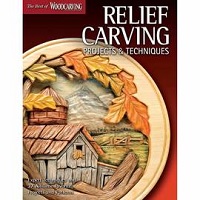CHAPTER XVII
WOODCARVING - STUDIES FROM NATURE—FOLIAGE



Medieval and Modern Choice of Form Compared - A Compromise Adopted - A List of Plant Forms of Adaptable Character.
It is high time now that we had some talk about the studies from nature which are to furnish you with subjects for your work. I shall at present deal only with studies of foliage, as that is what you have been practising, and I wish you to carry on your work and studies as much as possible on the same lines.
Between the few abstract forms, representing a general type of foliage, so dear to the heart of the medieval carver, and the unstinted variety of choice displayed in the works of Grinling Gibbons and his time, there is such a wide difference that surely it points to a corresponding disparity of aim.
Although there is no doubt whatever that such a striking change of views must have had its origin in some deeper cause than that which is to be explained by artistic
and technical development, yet I think that for our immediate [154] purpose we shall find a sufficiently good lesson in comparing the visible results of the two methods. Broadly speaking, then, the medieval carver cared more for general effect than for possibilities of technique. He therefore chose only such natural forms as were amenable to his preconceived determination to make his work telling at a distance. He had no botanical leanings, and rejected as unfit every form which would not bend to his one purpose—that of decoration on a large scale—and which he aimed at making comprehensive at a glance, rather than calling for attention to its details. He invented patterns which he knew would assist in producing this result, and here he further handicapped his choice by limiting it to such forms as would repeat or vanish at regulated intervals, reflecting light or producing shadow just where it was wanted to emphasize his pattern.
The more modern carver, on the contrary, offered an all-embracing welcome to every form which presented itself to his notice. He rejected nothing which could by any possibility be carved. Nothing was too small, too thin, or too difficult for his wonderful dexterity with the carving tools. His chief end was elaboration of [155] detail, and it was often carried to a point which ignored the fact that nearly all of it would become invisible when in position, or, if seen at all, would only appear in confused lumps and unintelligible masses.
Now, for many reasons, I think we had better take the medieval method as our model up to a point, and make a certain selection of material for our studies, based upon some relation to general effect, but not necessarily imitating a medieval austerity of rejection, which would be the merest affectation on our part. Upon these principles, and taking somewhat of a middle course, I shall here note a few types of foliage which I think may be useful to you in the work upon which you are engaged.
Leaf forms, with their appropriate flowers or fruit, afford the carver a very large proportion of his subject material. They serve him as principal subject, as bordering or background to figures of men or animals; they occur as mere detached spots, to break the monotony of spaces or lines; and in a thousand other ways give exercise to his invention.
As a general rule, those leaves with serrated, or deeply cleft and indented edges, [156] lend themselves most readily to decorative treatment. Large, broad leaves, with unbroken surfaces, and triangular or rounded outlines, are less manageable. Those most commonly taken as models are:
The Vine, with its Grapes.—This was freely used by medieval carvers, at first for its symbolic significance, but afterward even more on account of its rare beauty of form. The play of light and shade on its vigorous foliage, the variety of its drawing in leaf, vine, and tendril, and the contrast afforded by its bunches of oval fruit, caused it to be accepted as a favorite subject for imitation in all kinds of carving. It lends itself kindly to all sorts of relief, either high or low, in almost any material. It is so recognizable, even in the rudest attempts at imitation, that its popularity is well deserved.
The hop-vine shares some of these qualities, though much less strongly marked in character.
The Acanthus.—This leaf was first adapted for the purpose of ornament by the workmen of classical Greece. The inspiration was one of the few which they took directly from nature's models. It was also freely used by medieval carvers, [157] but with an insistence upon the flowing and rounded character of its surface forms; and again by the Renaissance artists, with a return to its classical character of fluted and formal strength of line. The graceful drawing of its elaborately articulated surface, and the extraordinary accentuation of its outline, provide an endless source of suggestion. It has been adapted in all manners, according to the fancy of the carver—sometimes long and drawn out, at others wide and spreading. Altogether it has been more thoroughly "generalized" than any other natural form.
The Oak, with its Acorns, appears in early medieval work, but without much attempt to represent its form with anything like individual character. In later work it has more justice done to its undoubted merits as a decorative feature by a clearer recognition of its beauty in clumps and masses. Fruit, other than the grape and a nondescript kind of berry, was seldom represented by medieval craftsmen; it formed, however, a marked feature in Renaissance ornament, where pomegranate, apple, fig, and melon were in constant requisition. [158]
Flowers in general were very little used in early times, and then only in a highly abstract form corresponding to that of the foliage. The rose and lily were the two most frequently seen, but they seldom had more individuality about them than was sufficient to make them recognizable. During the Renaissance flowers were treated with much more regard to their inherent beauties, and were represented with great skill and power of imitation, although often carried beyond legitimate limits in this direction. When dealt with as ornaments, rather than botanical details, they form a rich source of suggestion to the carver, and offer a ready means of contrast with masses of foliage. The rose and lily are such conspicuous flowers that they should, in modern times, be used in a way consistent with our demands for individual character and likeness. They should be fairly well defined and easily recognizable. It is quite possible to treat these flowers in a very realistic way, without endangering their effect as decorative details: they have both such distinguished forms in flower and foliage.
Flowers should be chosen for their forms; color should not be allowed to [159] deceive the eye in this respect, unless the color itself is suggestive of lines and contours.
Foliage should always be studied at its prime, never when it is dried and contorted in its forms.
Here is a short list of subjects, including those I have mentioned, all having a sufficiently pronounced character to make them valuable as stock in trade. Many more might be named, but these are chosen as being commonly familiar, and as being representative types of various forms.
For their Leaves and Fruit.—The grapevine, hop-vine, globe artichoke, tomato, apple, plum, pear, bramble, and strawberry.
For Fruit and Vine-like Growths (leafage too massive and smooth to be of much value without adaptation).—The melon, vegetable-marrow, pumpkins, and cucumber.
For Leafage, Flowers, or Seed Vessels.—The acanthus, oak, thistles, teazle, giant hemlock, cow-parsley, buttercup.
Of Garden Flowers.—The rose, lily, larkspur, peony, poppies, columbine, chrysanthemum, tulip, Christmas rose, Japanese anemone.
For Close and Intricate Designs.—Periwinkle, [160] winter aconite, trefoils of various kinds.
Many valuable hints on this subject may be gleaned by a study of Gerrard's Herbal, which is full of well-drawn illustrations, done in a way which is very suggestive to the designer.
A careful study of the outline forms of leaves is a schooling in itself, so much may be learned from it. It teaches the relation between form and growth in a way which makes it possible to use the greatest freedom of generalization without violating structural laws. The same causes which govern the shaping of a tree are present in the leaf, settling its final outline, so that, however wandering and fantastic it may appear, there is not the smallest curve or serration which does not bear witness to a methodical development, and to every accidental circumstance which helped or hindered its fulfilment.
You could not do better than make a collection of suitable leaves, press them flat and trace them very carefully, keeping the tracings together in a book for reference. Accompanying this you should have in each case a drawing of the leaf as it appears in its natural state, always [161] being careful to do this from a point of view which will accommodate itself to carving the leaf if you should have occasion to use it.

|
INFORMATION ABOUT HOW TO MAKE MONEY FROM WOOD CARVING |